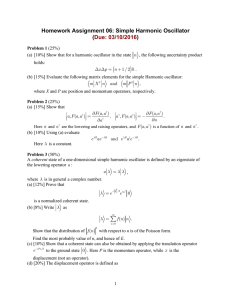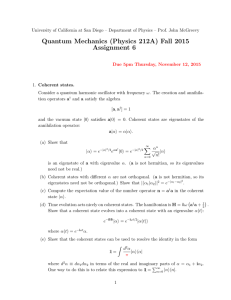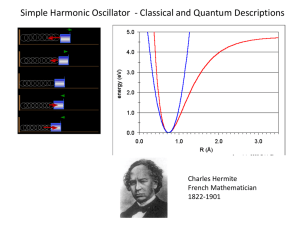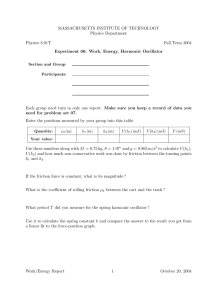Optional Problems on the Harmonic Oscillator
advertisement
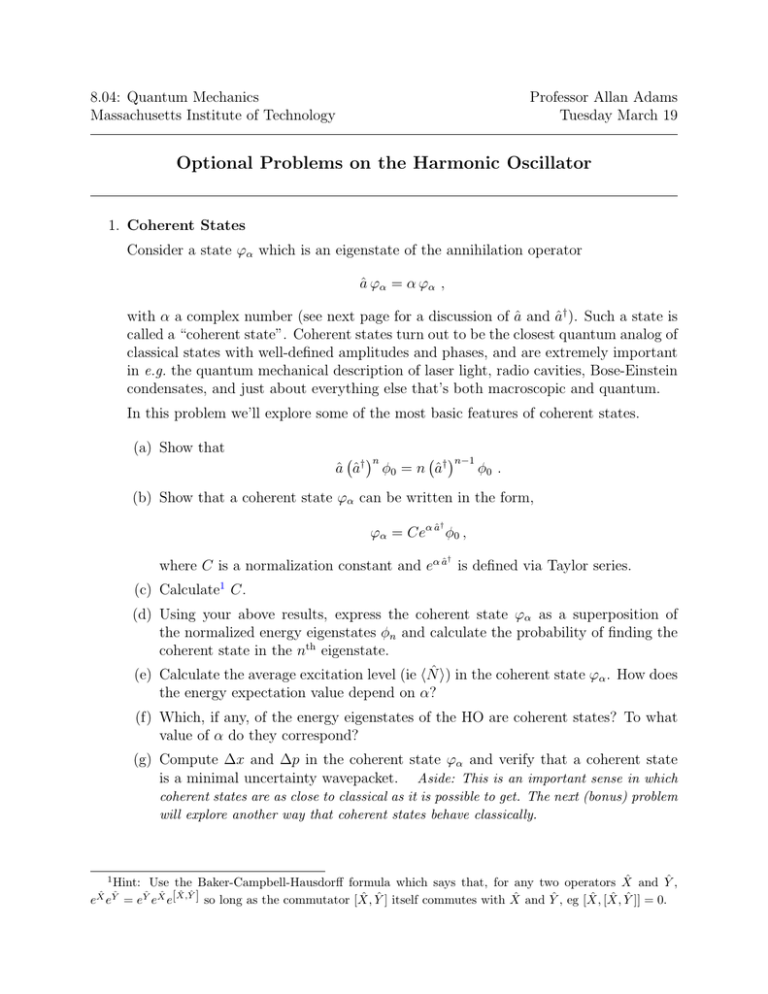
8.04: Quantum Mechanics Massachusetts Institute of Technology Professor Allan Adams Tuesday March 19 Optional Problems on the Harmonic Oscillator 1. Coherent States Consider a state ϕα which is an eigenstate of the annihilation operator â ϕα = α ϕα , with α a complex number (see next page for a discussion of â and ↠). Such a state is called a “coherent state”. Coherent states turn out to be the closest quantum analog of classical states with well-defined amplitudes and phases, and are extremely important in e.g. the quantum mechanical description of laser light, radio cavities, Bose-Einstein condensates, and just about everything else that’s both macroscopic and quantum. In this problem we’ll explore some of the most basic features of coherent states. (a) Show that â ↠n φ0 = n ↠n−1 φ0 . (b) Show that a coherent state ϕα can be written in the form, † ϕα = Ceα â φ0 , † where C is a normalization constant and eα â is defined via Taylor series. (c) Calculate1 C. (d) Using your above results, express the coherent state ϕα as a superposition of the normalized energy eigenstates φn and calculate the probability of finding the coherent state in the nth eigenstate. (e) Calculate the average excitation level (ie hN̂ i) in the coherent state ϕα . How does the energy expectation value depend on α? (f) Which, if any, of the energy eigenstates of the HO are coherent states? To what value of α do they correspond? (g) Compute ∆x and ∆p in the coherent state ϕα and verify that a coherent state is a minimal uncertainty wavepacket. Aside: This is an important sense in which coherent states are as close to classical as it is possible to get. The next (bonus) problem will explore another way that coherent states behave classically. ˆ and Yˆ , Hint: Use the Baker-Campbell-Hausdorff formula which says that, for any two operators X ˆ ˆ] ˆ [X,Y Yˆ X ˆ ˆ ˆ ˆ ˆ ˆ e e =e e e so long as the commutator [X, Y ] itself commutes with X and Y , eg [X, [X, Yˆ ]] = 0. 1 ˆ Yˆ X 2 8.04: Optional Problems on the Harmonic Oscillator 2. Harmonic Oscillators Oscillate Harmonically II Consider a particle of mass m in a harmonic oscillator potential with wave function ψ(x, 0) = 1 πβ 2 1/4 e − 1 (x−xo )2 2β 2 ~ where β 2 = mω . This is nothing but the ground state wavefunction displaced from its o equilibrium position, x=0, to x=xo (think of a stretched spring). When xo 6= 0, this state is not an eigenstate of the harmonic oscillator (think symmetry) and will thus evolve non-trivially in time. In this problem we will study its evolution. (a) Act on the initial state with the annihilation operator (re-expressed in terms of x̂ and p̂). What kind of a state is this? Hint: look back at the last problem... (b) Write down a formal expression for ψ(x, t) at a subsequent time t > 0 as a superposition of energy eigenstates. (c) Using the form of the energy eigenstates, φn (x) = Nn Hn (x/β)e the coefficients of this expansion cn ≡ (φn |ψ) take the form, 1 cn = √ n! x √o 2β n e − − 1 x2 2β 2 , show 2 that 1 x2 4β 2 o 2 Hint: You can do this in many ways, including brute force, but a particularly efficient and illuminating way involves the idea of a generating function, as follows. Consider the function 2 Z(u, s) = e−s +2su . Performing a taylor expansion in s gives, Z(u, s) = ∞ X Hn (u) n s . n! n=0 where the Hn (u) are the Hermite polynomials (to check, compare the first few terms in the taylor expansion to the table from lecture). Taking k derivatives of Z(u, s) with respect to s then setting s to 0 thus gives, Hk (u) = ∂k Z(u, s) . k ∂s s=0 Z(u, s) is called a generating function for the Hn (u). The beauty of the generating function is that many things you’d have to do one at a time with the Hn (say, integrate them against a gaussian...) can be done all at once by using Z to get a generating function for your quantities of interest. If you play around a little bit, you should be able to use Z(u, s) to build a generating function C(u, s) for cn and derive the stated result. 8.04: Optional Problems on the Harmonic Oscillator 3 (d) Substitute this cn into your formal expression for ψ(x, t) and square to show that 1 − 1 (x−xo cos(ωo t))2 P(x, t) = √ e β2 πβ Our initially displaced wavepacket evolves in time with fixed shape but with its center oscillating around the minimum with an amplitude xo and frequency ωo ! Hint: Take advantage of the generating function Z(x, s)! 4 8.04: Optional Problems on the Harmonic Oscillator 3. More on Coherent States, and a little Squeezing The “coherent states” ϕα of a harmonic oscillator of mass m and frequency ωo , which we studied above, are the eigenfunctions of the lowering operator â, â ϕα = α ϕα . In this problem we’ll illuminate the physics of these states by bringing to bear all of the operator tools we’ve built so far: the non-Hermitian raising and lowering operators ˆ =↠â and E=~ω ˆ ˆ 1 ↠and â, the Hermitian Number and Energy operators N o (N + 2 ), ˆq , and the Unitary time-propagator Uˆt . the Unitary symmetry operators TˆL and B Note: At no point in this problem will you need the functional form of any wavefunctions. Everything will follow from the various operators and their commutation relations. (a) To begin, verify the following commutation relations (with γ a complex number): h i L a, TˆL = √ T̂L , 2β h i iqβ ˆ a, B̂q = √ B q, 2~ ˆ ˆ a ˆ eγN = eγ eγN â , ˆ ˆ ↠eγ N = e−γ eγN ↠Physically, what do the first two commutators say about the set of coherent states? (b) Consider the state ˆpo Tˆxo ϕ0 φx o p o = B where ϕ0 is the ground state, â ϕ0 = 0. Deduce hx̂i and hp̂i in this state. How does the probability distribution differ from that of the ground state? Experimentally, if you are handed a harmonic oscillator in its ground state, how might you force the system into the state φxo po ? (c) Using the commutators above, verify that φxo po is a coherent state, φxo po ≡ ϕαo , and determine the corresponding eigenvalue αo . Use your results to give a physical interpretation for a generic coherent state ϕα with â-eigenvalue α.3 (d) Using the propagator Uˆt for the harmonic oscillator (cf problem 2e), and given the initial condition ψxo po (x, 0) = φxo po (x), we can formally write ψxo po (x, t) as, ψxo po (x, t) = Uˆt φxo po . Show that ψxo po (x, t) is again a coherent state with eigenvalue αt = αo e−iωt . (e) What are the expectation values hx̂i and hp̂i at time t? How do the uncertainties ∆x and ∆p vary with time t? How does the probability distribution P(x, t) vary with time? Hint: No computations should be required! 3 † Alternatively, use the Baker-Campbell-Hausdorff formula to directly show that φxo po = Ceαo â ϕ0 , where αo is the same value you computed in part (c). Is φxo po is properly normalized? 8.04: Optional Problems on the Harmonic Oscillator 5 (f) Now suppose we put our system in the state ϕαo and then immediately squeeze the potential so that the frequency of the oscillator increases from ωo to ω = s ωo . Since the frequency appears in the definitions of â and ↠, the state ϕαo will not be a coherent state of the new potential. However, it is an eigenstate of a linear combination of the raising and lowering operators of the new potential, âs and â†s . Find the linear combination ˆbo = µo âs +νo â†s of whom the “squeezed state” ϕαo is an eigenfunction with eigenvalue αo . Observe that |µo |2 −|νo |2 = 1. Aside: In general, “squeezed states” Φβ are eigenstates of linear combinations of â and ↠, ˆb Φβ = β Φβ , ˆb = µ â + ν ↠, h i where µ and ν are complex numbers satisfying |µ|2 −|ν |2 = 1 so that ˆb, ˆb† = 1. (g) Using the propagator Uˆts for the squeezed potential, show the time-evolved state Ûts ϕαo is a squeezed state with the same eigenvalue under a different operator, ˆbt Uˆ s ϕαo = αo Uˆ s ϕαo , t t ˆbt = µt â+νt ↠. How do µt and νt depend on time? (h) Determine hx̂i and hp̂i, as well as the widths ∆x and ∆p, in the state Uˆts ϕα . What has squeezing done to ∆x and ∆p? How do ∆x and ∆p evolve in time? Sketch the trajectory of hxi and hpi as a function of time, then indicate the widths ∆x and ∆p by using them to define an ellipse centered around the expectation values at each moment in time. Indicate the effect of squeezing in your sketch. Aside: Lest this seem like so much formal manipulation, you should know that squeezed states of the quantum harmonic oscillator turn out to be exceedingly important experimental tools, used in everything from atomic physics to the detection of gravitational waves. Seriously! If you’re curious about this, the world’s expert is MIT’s own Prof. Nergis Mavalvala, an excellent physicist and a powerful quantum mechanic. MIT OpenCourseWare http://ocw.mit.edu 8.04 Quantum Physics I Spring For information about citing these materials or our Terms of Use, visit: http://ocw.mit.edu/terms.
